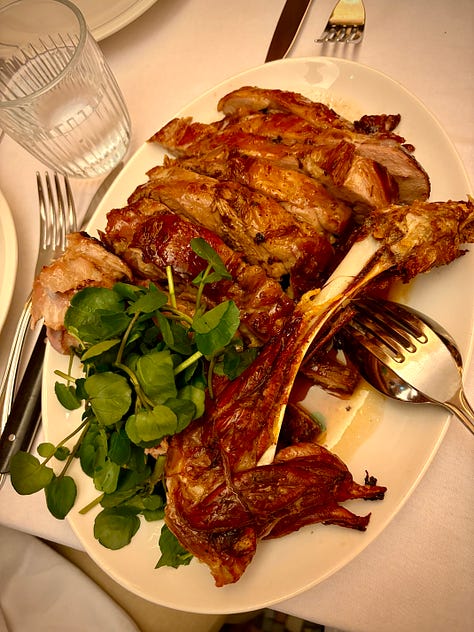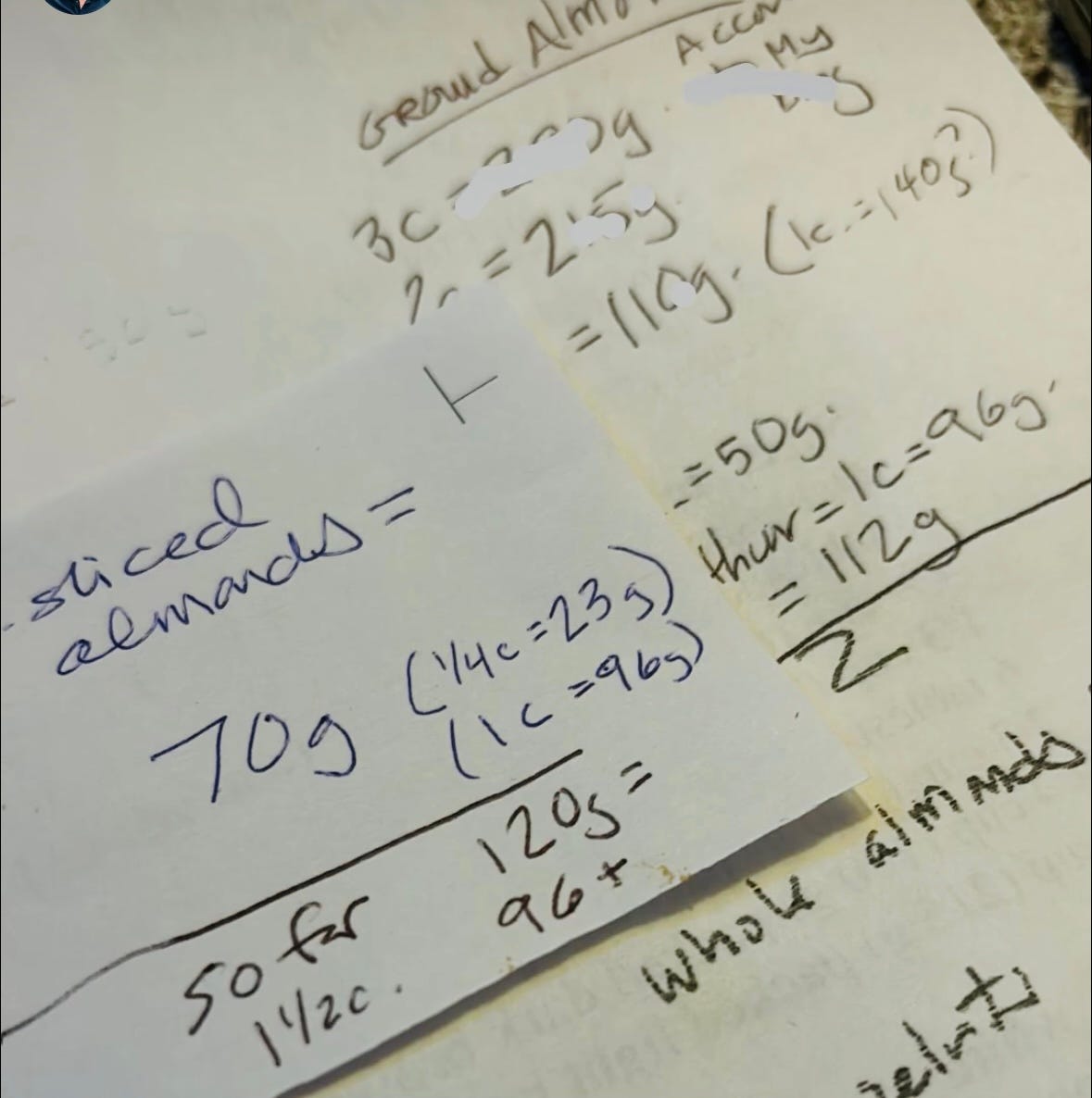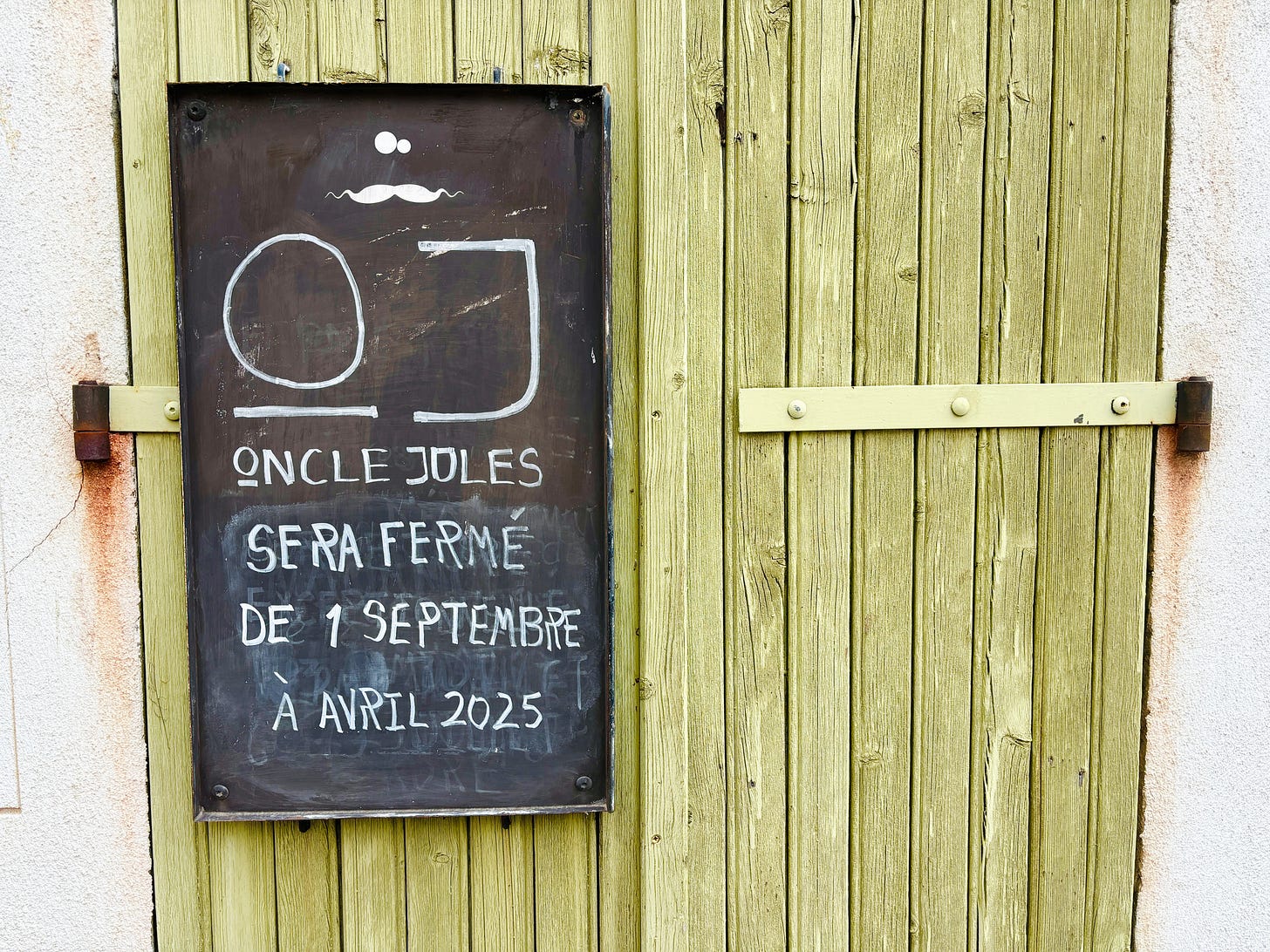October 2024 Newsletter
What's going on...
Someone once said that being a writer is like having homework for the rest of your life. Remember how great it felt when you left school and realized that you’d never have to do homework again? It was similar to that feeling when you realized that you’d never have to take any kind of test again or be judged…until you move to a foreign country and have to apply for a visa, take language tests, and be judged.
When you’re in the vortex of writing a cookbook, you tend to block everything out in your life (sorry, Romain!) for the couple of years it takes to get it all together. You do learn who your friends are, which are the ones who understand when you have to cancel dinner with them because you’ve got a sinkful of pots and pans to wash after a day of recipe testing, or when you leave a dinner party at 10:30pm (not the usual 1am in Paris) because you were up at 6am testing tart doughs, or seeing how the custards you made the night before set, whether cornstarch or flour was a better thickener.
You also have to gather ingredients, and it’s amazing how fast you can go through 3 dozen eggs, 6 pounds of butter, and 4 kilos (9 pounds) of chocolate. I’m used to waiting outside the supermarket at 8:30am for the motorized roll-up door to open, and I often just wear sweatpants and my Birkenstock super-grip kitchen clogs since I have a deep dislike of getting dressed first thing in the morning.
However, last week, a very nice young woman stopped me and said, “Are you David Lebovitz!?” With my unshaven face, flour in my eyebrows, work clogs, and tattered t-shirt (which I wear so my nice shirts don’t get messy), I said, “Um…yes,” and apologized for my appearance, and quickly headed to the Marché U supermarket where, as is often the case, they were just starting to restock from the day before, so half the things I needed weren’t on the shelves yet, and would probably/hopefully be by that afternoon, prompting me to have to go back again. I start early in the day since I often have to go to multiple food shops and markets to find everything that I’m looking for.

I finally went “professional” and got a card to shop at Metro, a large store where only people who have professional status in France can shop (sorry, égalité doesn’t apply…), so I can buy certain things in bulk, like butter, chocolate, and sugar. They’re open from 6am to 2am and, even better, the other shoppers aren’t as combative and confrontational as non-professional Parisians are when shopping:
I resisted shopping there for a long time as the term “Cuisine Metro” is applied to cafés and restaurants that buy pre-prepared food from there. But not to worry, I steer my five foot (1.5m)-long shopping caddy clear of the shrink-wrapped frozen quiches, spray-on tart glazes, and crème anglaise sold in plastic jugs, and stick with the butter, cream, and even Chartreuse, which I found there for €30 ($32) a bottle, and was sorry/not sorry that I bought them both.
When you’re done writing your book, after you turn in your manuscript, the publisher sends it off to a copyeditor to check and query you about anything (and everything) in the manuscript that’s not clear or might be missing, or to clean up your faulty grammar. (Bakers tend to focus on food, not whether one should use “that” or “which.”) There may be questions such as, “When you say ‘chill,’ what does that mean?” (which seems obvious to me) or “When do you add the vanilla?” which you may have missed and is extremely helpful. When your manuscript has 111,653 words, keeping track of each and every one of them is a challenge.
And then, there are the numbers. I started adding metrics to my recipes over twenty years ago when most authors and publishers weren’t doing it, which is helpful for readers but requires a lot more brainpower to write in two systems of measurement. Consequently, it takes me a really, really long time and is slow-going (is there a limit to how many Junior Mints one should eat in a day?) making sure they all align. There have only been two times in the last ten years that I’ve cried: One was after my last visa renewal meeting, and the other was doing copy edits last week, but I’m almost there. We’re doing the photos this month here in Paris, and I’m excited for the team to come, where we’ll turn my kitchen, and the city of Paris, into our photo studio. I can’t wait.
I don’t know about you, but my dance card always seems to be full. One good thing about living in France is that you learn to say Non. I used to hate saying it and even watched The Year of Saying Yes, a TED Talk by Shonda Rhimes on the advice of a friend who, along with her husband, took her three kids around the world on a sailboat because they wanted to. But as my friend
postulated in her book Joie: A Parisian’s Guide to Celebrating the Good Life, that in France, non is self-care and means that you’re prioritizing what’s important to you. The other side is that baking and writing are about giving — that’s what bakers do and what comes naturally to us.Two books I’ve been reading are How to Do Nothing and Four Thousand Weeks: Time Management for Mortals, which
summarized for me (because I got to page 33 and still hadn’t learned anything) as: Prioritize three things in your life, and focus your attention on them. It’s interesting to think about, but not sure I can whittle it down to three. But it’s an intriguing idea.We took a nice vacation during the first half of September to the south of France. I wrote about where and what we ate here and here:
Where and What We Ate on Vacation
We took our vacation this summer in September, which was a good thing as the Paris Olympics turned out to be a lot of fun, and the dire predictions about the city being overcrowded and disorganized didn’t come to pass. Although, a number of small businesses were severely impacted by the loss of business due to people staying away from Paris this summer …
…and I’m working on a post about finding flea markets in France, with some photos of some of my summer finds, found while combing through places like this!
Yikes… That was quite a treasure hunt. We spent a lot of time hunting down treasures — fortunately Romain and I have similar interests (when I start my top-three list, I hope I can keep “Romain” and “antiquing” on it, but it’ll be tough picking out what will be the third) — we did take time to go to the beach when mistral-like winds and sandstorms died down, and ate oysters, read books, and drank rosé.
When we arrived back home in Paris, mid-September, we found that our fig tree yielded only one, lone fig this year. Thankfully, where we stayed in Provence, there was an amazing — and amazingly prolific — fig tree that was so heavy with figs that they’d drop to the ground in front of us, soft as half-filled water balloons, heavy with sticky syrup, and I picked as many as I could. I am sure I ate at least two dozen a day.
In the end, we lugged three cases’ worth of figs away from Provence, along with flea market finds, and a lot of Not Frères pottery, which I justified on the pretext that I’d be using them for the photos in my book.
When I got home, I put on my tattered t-shirt and made a few dozen jars of fig jam with my bounty, which we’ve been enjoying every morning, and I suspect we’ll be enjoying until next year at this time, when I hope our fig tree springs back into action.
There have been so many restaurants opening in Paris, and a number of visitors, that I’m doing my best to try new ones and revisit favorites. When a visiting friend made plans for dinner in Paris on a Sunday night at the hard-to-get-into Bistrot des Tournelles (that’s definitely not serving “Cuisine Metro”), after we had cocktails at Honey Moon, we arrived for our 9pm reservation only to find that he’d reserved for the following weekend and that the little bistrot was booked solid.

So we ended up at nearby Grande Brasserie, which is open on Sundays (when a lot of restaurants are closed in Paris) and serves very good renditions of traditional French food.





They took over the space from Bofinger, just across the street (which is skippable), and we started with their prize-winning œufs mayonnaise served with celery remoulade, along with fresh oysters and their excellent pâté en croûte. Since there were five of us, we shared a roast shoulder of lamb, which is served with salad and potato gratin, and a slab of aged côte de bœuf, which came with excellent fries. French people like meat really, really rare (called bleu), and even what is considered rare elsewhere, in France can be closer to bleu than people are used to. So we settled on saignant, which is medium-rare, and it was perfect.
Dessert was a shared plate of profiteroles, drowned in lots of chocolate sauce, and we ended with glasses of yellow Chartreuse while closing the place down close to midnight.
So that’s what I’ve been eating, drinking, buying, and thinking. The weather has been unseasonably chilly here; this week is going to go down to 5ºC (41ºF). There are the usual fall strikes in France coming up, including a major one scheduled for today, October 1. Election season is around the corner, and voting is a right that not everyone has. So if you have it — use it! (Toll-free numbers for voters who live outside the U.S., who have questions about how to vote from abroad, are here.) I’ve got more friends on the way and look forward to seeing them, trying some new restaurants and visiting some favorites, and finishing up my book, which is due back to the publisher next week, so I’m heading back to work on that…pronto!
-David
Links I’m Liking
Is Italian cuisine…American? (
)The most famous café in Paris sets up for a reboot. (NYT/unlocked)
Live in France and want to block those annoying telemarketing calls? Bloctel may help. (République Française)
What makes — or breaks — a cookbook? (
)My French doctor laughed when I asked her for a prescription for a week (or two) in a spa, but I guess it’s possible. (New Yorker, possible paywall)
Iconic French glassware company, Duralex, files for bankruptcy…again. (Le Monde)
…and Tupperware, too. (Reuters)



Automne (restaurant) in Paris
The rentrée happens in Paris in September when everyone comes back from vacation. Not only is it back to school and back to work, but it’s also the month when restaurants, shops, and galleries have open houses and press events. I was excited to be invited to Automne restaurant. I bike past it all the time and think that I should go there, but by the time I get home, another thought has taken that space in my mind. So it was nice that someone fixed a date for me to try it.
I, along with a few other food writers, had a 7-course lunch that turned out to be one of the best meals I’ve had in Paris in a while. We had a few amuse-bouches at the bar with glasses of sparkling crémant d’Alsace (Champagne is out, crémant is in), and some of the courses we enjoyed were Salsify with summer truffles and celery root (above, center), line-caught tuna paired with crisp sweetbread and mushrooms, which sounded odd, but worked, a tartlet of foie gras on pain d’épice (spice bread) crust, an outstanding dessert of red plums, mirabelles, soy milk, and dill, and a second dessert (above, right) of black figs, feta, sesame, and red wine, which may sound a little strange. But in the right hands, feta and dill can work in desserts, as they did here.
I normally avoid wine pairings which involves a different glass of wine with every course. I find it hard to appreciate seven different wines, one served right after another. It’s too much for me — I’d rather try, and linger, with two or three interesting wines, but the Alsatian wine pairings were brilliant nonetheless.
People are skeptical of Alsatian wines, thinking they’re sweet. Yet the greatest wines in the world are sweet, from Château Y’quem (often considered the best wine in the world), to muscat de Beaumes-des-Venise, Maury, late-harvest Riesling, ice wines, and port. And they’re not just for dessert, sweet wines (vins doux, in French) go well with first courses, such as terrines or melons with prosciutto. Be sure to serve them well-chilled.
Although this was a press meal, whenever I give a shout-out to a restaurant, I always consider if it’s worth it for you to go, or for me to go back…which I will. Dinner here is €110 for 5 courses and €145 for 7 courses at night, and €75 for lunch. The meal was better than most meals I’ve had in 3-star restaurants in Paris, where the menus run over €400 per person. So while it’s not cheap, I don’t consider it excessively priced. (Prices in France include tax and tip.) You can eat for less in Paris, but it’s certainly a nice experience if you’re interested in a fine dining experience along with some very good wines. Just be sure to leave the tattered t-shirt and Birkenstock clogs at home.

















Your newsletters are wonderful. Rich in content, well-written, friendly and also professional. I file them away for reference and inspiration for both cooking and travelling. I’m jealous of the fan who met you at Metro—I would have been able to tell you in person. (But I would be brief—you’re busy!). Cheers from Canada.
I really like your metric measurements. I've stopped buying any cookbooks that only uses cups etc. In a way it's understandable that many US publishers choose to forego metric measurements since the book(s) are not directed to any other market but the american.